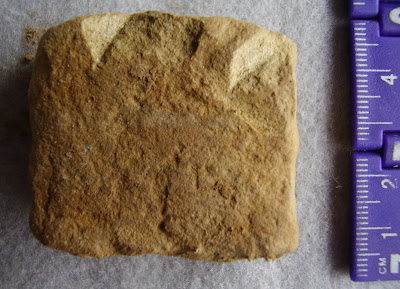Nov. 14, on an unusually warm 70 degree afternoon, I took my girlfriend Lyn Niday to the field find location of the artifact in the prior posting, a possible Belted Kingfisher head figure stone. As we surface hunted a small hill in a plowed field, Lyn identified a possible horse's head figurine, it caught her eye as such, and I found a squared off stone and a rare hexagonal stone in the immediate area of the horse's head, estimated 10 meters. The horse figurine appears to have multiple indicators of human stone crafting to complete the image.
Side 2 with (cm) scale. In this view, one may see the cut of the stone in bottom left which accommodates a grip. The removal does not impact the image on the other side of the stone. I have wondered if many of these types of pieces were used like toy puppets. The idea of a talking horse is not so far removed from our culture as was seen in the "Mr. Ed" television series of the 1960's.
 Close up view of horse's snout area as if being held like a puppet. There are nostril holes and an incised mouth line.
Close up view of horse's snout area as if being held like a puppet. There are nostril holes and an incised mouth line.Hexagonal stone with 2 large sets of lines intersecting at 90 degree angles, starting and stopping within the frame of the artifact. Click photo to expand.
Agriculture plows don't make sets of 90 degree lines which begin and terminate within the edges of the artifact as seen in the hexagon artifact above. Plows do make marks like those seen on this little squared off piece, unlikely to be a product of mother nature. It looks like the plow blade caught this little square piece and moved it in the soil and then caught it again in the rotation before moving away.
I have wondered if this site area, with so many little iconic stones, may have been a children's area at one time. Crude tools and lithic debitage are also prolific in the area. A horse's head like this, not likely from historical times, may indicate a Pleistocene human occupation making a recognition of horses in their environment. Equus species were present here in Ohio in Pleistocene times. They went extinct in the Pleistocene-Holocene mass extinction event and were not in the Americas until the Spanish reintroduced them in historical times.
Great find Lyn Niday!
Pleistocene Equus article:
THE OHIO JOURNAL OF SCIENCE 64(6): 423, November 1964,
The material here is a beautiful black and white striped granite. This is a slightly pitted stone, the pit the result of pounding activity. The pitted area takes up approximately the top 1/3 of the artifact as pictured here. This is a hand hammer with two fins to accommodate the curvature of the hand. It was found in the immediate context of everything else here as well as the artifact from the "Belted Kingfisher" prior posting.
-kbj





No comments:
Post a Comment